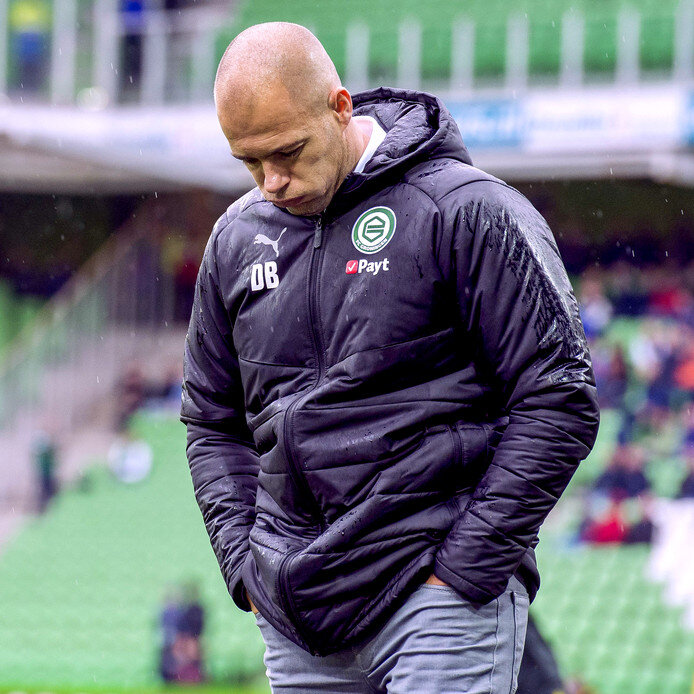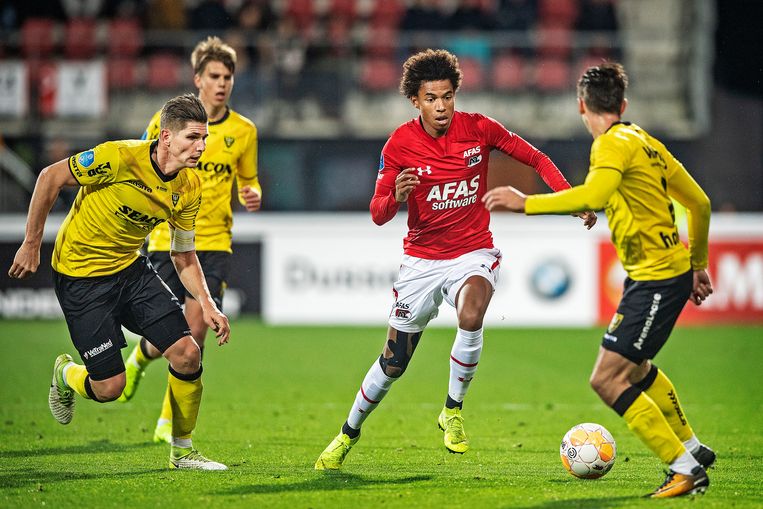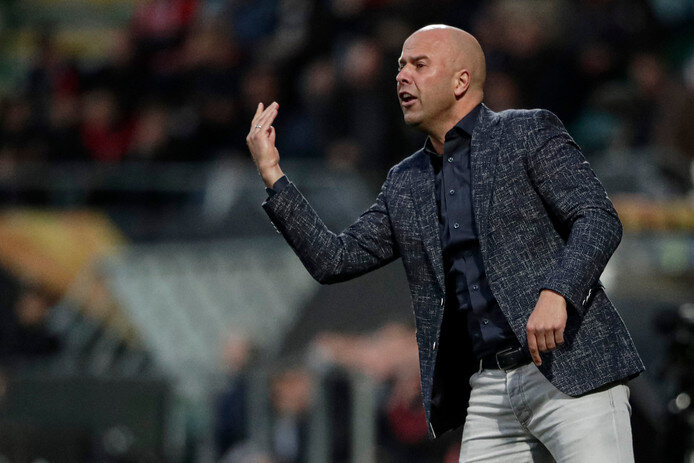Danny Buijs’ rigid FC Groningen

Danny Buijs made the step up from amateur football with Kozakken Boys to the Eredivisie with FC Groningen after the club’s Technical Director, Ron Jans watched his training sessions and was impressed with his interview. Ron Jans described him as a ‘laptop trainer’ as the 37-year-old recovered from a terrible start in top flight management last season to lead his club into the Europa League playoffs. Buijs seeks to play intense and fast-paced football, pressing high without the ball while looking to be direct and incisive while in possession. He is growing as one of Dutch football’s most intriguing young managers as the country seeks to evolve tactically like other countries on the continent.
Build-up
Groningen normally utilise in a 2-2-4-2 with a 2+2 as Buijs prefers to push his fullbacks into the higher areas of the pitch. Groningen will create passing angles to the six space but with the centre-backs positioned in the deeper areas of the pitch, Buijs encourages his centre-backs to drive the ball into the higher areas of the pitch to attract pressure, create space in between the lines and create angles to the six space. Groningen centre-backs will also normally circulate the ball amongst each other while involving goalkeeper, Sergio Padt in build-up play to spread the ball to the free-man which is the ball-far centre-back or fullback. The centre-backs will normally play the ball to the fullbacks if they face significant pressure in the central areas or the opposition have closed passing access to the six space.
The fullback will either surge into the wide areas to create crossing opportunities or the inverted winger and ball-near defensive midfielder will move into the wide areas to create three-man triangles for rotations. A frequent passing sequence in the wide areas is a player in the half-space moving into the higher wider areas to draw markers and create passing lanes into the centre for the fullback. The centre-back normally moves the ball to the flank as an avenue for the fullback to eventually move the ball back to the centre. In the picture above, Groningen have created the perfect situation as the player in possession is angling a pass into the six space where the defensive midfielder could pass the ball back to the other centre-back who will work a pass for the other six to play the ball out wide for a cross. The defensive midfielder can also receive the ball and play a pass in between the lines for one of the players positioned behind the opposition’s second wave of pressure. Or the centre-back can drive the ball in the higher areas to attract pressure, create a three chain for numerical superiority and play the ball out wide or in between the lines. The fullbacks are highly positioned and providing width as the wingers have moved into the centre while the strikers are holding the centre-backs as one striker is prepared to drop with his partner prepared to make a run in behind.
Under pressure, one of the players in the double-pivot will drop next to the centre-backs to form a three chain as this gives Buijs’ side numerical superiority as well as better passing angles for the centre-backs to work the ball in between the lines or into the wide areas. The two wider players in the three chain can drive the ball into the higher areas and work passes for the inverted wingers in between the lines to play combinations or create through ball opportunities for runners in behind. They also have better access to the highly placed fullbacks who can work quicker interchanges to create better crossing opportunites. In the picture above, Groningen have switched to a three chain as they have players in between the lines while the fullbacks are creating width.
In the picture above, it is noticeable that the defenders are working a switch ball to the opposite flank as spreading the ball and stretching the opposition is a big part of Groningen’s play in possession. The opposition have shifted to close down the space on the ball near flank as Groningen have responded by switching the ball to the opposite flank where the fullback will be in space and will have a direct crossing opportunity. Throughout, his season and a half in charge, Buijs’ teams have sought to create a balance between going direct and creating connections on the ground. Groningen can sometimes be too quick to go direct as in the photo above, Groningen can work a ball to the fullback in the wide areas, before they can play a 3v3 move to release a player in space out wide or in the half-space.
Groningen normally operate as a 3+1 when they switch to a three chain in build-up as they seek to work opportunities for the attackers can run behind. They can also switch to playing long-balls as Buijs has worked with diminutive and quick strikers as well as tall and aerially proficient strikers. The centre-backs will circulate the ball amongst each other as usual with the striker driving forward then playing a long ball into the attackers. The long ball could allow the striker to layoff for a teammate as well as a flick on for a striker to run onto in behind. Groningen can be hasty with the way the utilise long balls which comes as a detriment to their build-up play and creation of high quality opportunities.
Direct attacking play and switching
Buijs normally utilises a 4-2-3-1 or 4-4-2 shape as one of their strikers will drop deep off the front line as a conduit for build-up play and an option for passes in between the lines. In their 2-2-4-2 or 3+1 build-up shape, Groningen will have two attacking players in between the lines in front of the six space as an option to receive passes in between the central lines. However, Groningen also move the ball out wide to the fullbacks who drive the ball forward and then move the ball into the centre in the final third. In the final third, Groningen will utilise runs into the centre as well as dummy movements to create space for high quality shots in and around the box. Buijs also has highly placed fullbacks so Groningen can switch play to the weak side in the final third in order to create crossing opportunities.
In the photo above, Groningen have stretched the pitch with an attacker dropping deep as well as an attacker occupying the centre-backs as an option for long ball flick-ons as well as direct balls in behind. The deepest-lying midfielder, Azor Matusiwa is in possession and looks to be turning away from pressure or play the ball back to the centre-backs so the centre-backs can drive forward to attract pressure and switch the ball to the player in space on the flanks. However, if the passing lanes are available, the centre-backs will drive forward and play to one of the players in between the lines who will then distribute the ball into the wide areas for a cross into the box. For crosses into the box, Groningen utilise cut backs to the top of the box but if it is a cross from an unorthodox area then Groningen will cross into the six-yard box into the space between their striker and the opposition goalkeeper for tap ins. With Joel Asoro and Kaj Sierhuis up front, Groningen prefer to utilise low crosses rather than high crosses.
One of Groningen’s most frequent attacking routines is a long ball from deep with a knock-on by a striker for his partner to run onto in behind the defence and have a 1v1 opportunity with the keeper. Against higher pressing teams, Groningen evade pressure and can get over the opposition high-block and use their quick strikers to get in behind to score. Groningen will also play balls into attackers in the channels, so they can go in behind and play cut-backs to players making runs in the central areas to score.
At certain periods of his tenure in professional football, Buijs has utilised a more traditional striker like Paul Gladon and Charles Benschop in a more direct system with long balls and early crosses to them. Buijs strives to find the balance between more direct football and a more dominant football philosophy with Joel Asoro and Ramon Lunqvist as his attackers for the rest of the season and 18-year-old starlet, Romano Postema moonlighting with the first team.
Counter-pressing
Buijs prefers to instil a ferocious counter-press as these situations as well as standard pressing situations can lead to Groningen creating opportunities for rapid counters in the opposition half. Groningen attackers have counter-pressing responsibilities as this is one of the reasons that Buijs prefers to use quicker and more energetic attackers. The moment the ball is lost in the opposition half, attackers must track back to create numerical superiorities and overloads to regain possession. Groningen will seek to man-mark, all of the players in the area of the turnover to cut out the player in possession’s direct passing lanes as they could allow the opposition a few passes before moving towards the player in possession to suffocate them. Groningen can also force long balls which their defenders regain in the higher areas as they will look to string together quick attacks from dominant positions.
In the photo above, Groningen have lost possession in the higher areas and have worked a 3v1 situation, denying him the forward pass or the opportunity to switch the ball to the opposite flank as they have teased the back pass to him as if he plays the pass, the player coming inside from the wide area will move across to intercept. If that fails then, the unit of three will then shift to press until they force a long ball or regain possession. The attacker is also dropping back to support as the ball-near winger has also moved inside to support as if the opposition player in possession manages to turn out of pressure and work a pass through the lines, the centre-backs will push up to regain possession. Mike Te Wierik and Ko Itakura are intelligent at anticipating pressure and pushing up to regain possession before driving the ball into the opposition half.
Groningen work a number of long balls and switch balls which do not have the same high rate of completion of shorter passes on the ground, so counter-pressing is an integral facet of their style of play. They can play a long ball over pressure which the opposition centre-backs will recover as Groningen will push forward and seek to regain possession in the opposition half as ways of circumventing pressure and creating quick attacking patterns in the opposition half. They will also shift across to laterally press switch balls unless the fullback is isolated and then they will drop back into their defensive shape. However, if the winger is available from a switch then the winger will move from his central position into the wide areas to press the ball, the ball-near striker will then cut off the passing lanes into the centre while the ball-near striker will move into the wide areas to pick up a marker as the fullback will push forward for press security. The strikers will normally shift to cut out passing lanes with a horizontal body shape in counter-pressure as Kaj Sierhuis was one of the best attackers at switching in between the attacking and defensive phases of the game.
Pressing
Groningen seek to suffocate their opponents from a defensive standpoint as they push up to press the ball and regain possession in the higher areas. They normally press in their standard flat 4-4-2 shape or they will sometimes utilise a 4-2-3-1 while also switching to a diamond in certain situations. In the photo above, Groningen are pressing the ball in a man-oriented fashion with the striker pushing up to mark the widely positioned centre-back who is about to receive the ball while his strike partner is moving to cut out the passing lane to the other centre-back. The winger is pushing up to engage the player in possession while cutting the passing lane into the fullback as the midfielder dropping deep will be followed by Groningen’s ball-near midfielder.
Groningen seek to hem their opponents into this corner of the pitch to force a loose pass or long ball to regain possession or regain possession directly in order to orchestrate a quick attack. If the centre-back plays the ball back to the keeper then, the striker closest to the keeper will push forward to engage him and if the keeper is in possession for a longer amount of time, both attackers will end up pressing him to force a turnover. Groningen’s fullback and defensive line will push up to mark wingers and attackers giving them better opportunities to intercept loose passes into the channels.
Groningen will also adapt their 4-4-2 pressing shape to the shape of the opposition as if the opposition utilise a three-chain, Groningen will continue pressing them with two markers. However, if the opposition have a midfielder dropping into a three-chain situationally during the game, at times his midfield marker will track him while his midfield partner and closest winger will push up to cover the spaces. Groningen will always have a striker pressing the keeper as his strike partner will then move to close down the goalkeeper’s most direct pass to force a long ball as Buijs has instilled a ferocity in defensive work that can be quite foreign to teams outside the top four in the Eredivisie. In one of his earliest interviews with Voetbal International, Buijs described his football philosophy with a story of how he put in a strong challenge on Mark Van Bommel as he expects his team to not be deterred by any opponent and to defend with heart.
Defensive shape
Buijs has been compared to Diego Simeone due Atletico Madrid and Groningen’s similar approaches to defending and their statistical resemblances in their offensive and defensive output. Buijs like Simeone defensive in a 4-4-2 shape with ferocity in all areas as passes out wide and back passes will trigger Groningen to switch into a higher press. In the photo above, Groningen are in their standard 4-4-2 low block as their player’s responsibilities are easily determinable. The centre-forwards are marking the opposition centre-backs, the wingers are marking the opposition fullbacks and the midfielders will be triggered by any passes into the opposition central midfielders. In their defensive block and press, Groningen will move as a unit, keeping spaces in between the lines small with the players aware of their man-marking responsibilities.
Groningen are in a narrow block as they have forced the centre-back into a long-ball as they are well drilled at closing and controlling the spaces, especially when the opposition move into their half. The centre-backs will be shielded by the midfielders as the spaces in between the central lines will be closed as balls into this area will result in centre-backs pushing to regain possession and midfielders sticking tightly to markers. Groningen have a tigerish attitude to defending the wide areas as the ball-near midfielder, fullback and winger will shield that zone looking to force back passes, so the strikers can switch to the pressing phase.
If the winger is in a narrow position with the fullback on the flank when the ball is played, the fullback will push up to engage the player in possession to force a back pass where Groningen can press with the wingers and strikers leading the pressure phase. The centre-backs will also be drawn into the wider areas to make a challenge and prevent the opposition strikers from having access to the channels. Groningen manages to keep the distances so small in the defensive phase that if a player is drawn out of position, it is manageable for them.
Conclusion
Buijs’ is on of the Eredivisie’s first iterations of a ‘laptop-trainer’ as he brought a laptop to his interview with the Groningen staff to explain his tactical system to them. He has had to work his way up, even travelling to Liverpool to learn from Ronald Koeman while he was at Everton. Groningen have continually backed him with investment in the transfer market after his first six months as well as extending his contract by two years recently. He has had to deal with departures as Groningen are in the midst of a complete financial restructure as the 37-year-old has guided them to a position that is 13 points clear of the relegation zone and on the cusp of a second Europa League playoff spot in a row.











